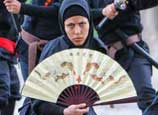
Martial arts
Chinese martial arts, which has a long tradition and derived from the one branch of Buddhism and absorbed the dynamic exercise of Taoists and the skills of attack and defense from the military, has developed into one of the three schools of Chinese martial arts, the Emeiquan and passed downed until today.
Poems
Mt. Emei, as a world famous Buddhist holy site, has a close connection with the praise, narrative and transmission of celebrities, scholars and poets. Famous poets such as Li Bai and Su Dongpo wrote many poems that praised Mt. Emei, which are still very popular among people. Furthermore, there is also the former residence of Guo Moruo in Shawan Town, which is not far away from the Er’eshan Mountain (Suishan Mountain in ancient times). Guo Moruo wrote many poems about Mt. Emei and is indeed a poet of Mt. Emei. The autograph “world famous” signed by Guo has become a rare treasure.
Leshan Giant Buddha
The Leshan Giant Buddha is located at the confluence of the Xiwan Peak on Lingyun Mountain, which is situated on the east of Mt. Emei, and the Binmian River, Dadu River and Qingyi River. The Buddha statue is a Maitreya sitting statue, which was carved around the mountain in the early eighth century and constructed over a period of 90 years. The Leshan Giant Buddha, which is 71 meters high and 60 meters high in sitting stature, is the tallest stone-carved Buddha around the world. The Giant Buddha carries the Jiuxiang Mountain on its back and faces the confluence of three rivers, the lines are smooth and its proportion is well-balanced. The Giant Buddha looks solemn and respectful and occupies the south-north walls and has 90 stone-carved statues from the Tang Dynasty. Among them, the “Pure Land” Shrine and the “Three Buddha” are excellent artworks and all have artistic value.
There are many historic sites in the scenic spot of the Leshan Giant Buddha including the meander core from the Qin Dynasty, cliff-tombs from the Han Dynasty, the Buddha, towers and temples from the Tang Dynasty and Jiuding City where the Song Dynasty fought against the Yuan Dynasty. The manmade landscapes are dense and integrated with the natural landscape, and both are glorious.


















 Wild Siberian tiger kills cattle in NE China
Wild Siberian tiger kills cattle in NE China


![]()
